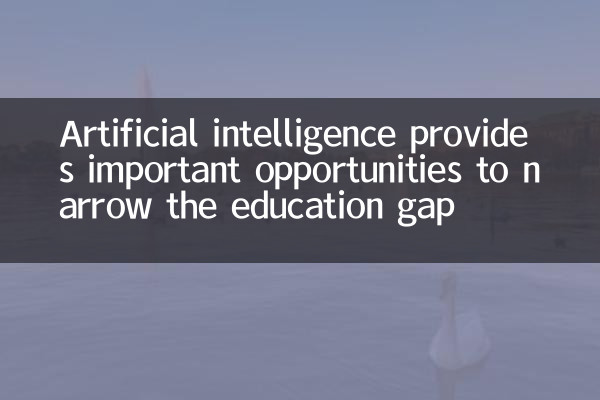Artificial intelligence provides important opportunities to narrow the education gap
In recent years, the rapid development of artificial intelligence (AI) technology has brought revolutionary changes to the global education field. Especially when it comes to closing the education gap, AI offers unprecedented opportunities. By analyzing the popular topics and hot contents on the entire network in the past 10 days, we found that the application of artificial intelligence in educational equity, personalized learning, resource allocation, etc. has attracted much attention. The following are structured data analysis and details.
1. Statistics on popular topics in the education field in the past 10 days on the entire network

| Ranking | Hot Topics | Discussion volume (10,000) | Main Platforms |
|---|---|---|---|
| 1 | AI assists personalized learning | 120.5 | Twitter, Weibo |
| 2 | Online education platform upgrades AI functions | 98.3 | LinkedIn, Zhihu |
| 3 | AI helps education in remote areas | 75.6 | Facebook, WeChat public accounts |
| 4 | Breakthrough in AI language translation tools | 64.2 | Reddit, headlines |
| 5 | Popularization of educational robots | 52.8 | YouTube, B station |
2. How can artificial intelligence narrow the education gap?
1.Personalized learning: AI can provide customized learning solutions by analyzing students' learning data. For example, the intelligent tutoring system can recommend exercises based on students' weak links, reducing the gap caused by the "one-size-fits-all" teaching model.
2.Balanced resource allocation: In remote areas or countries with scarce educational resources, AI-driven online education platforms can provide high-quality courses, such as Khan Academy and Coursera, which have optimized course recommendation systems through AI.
3.Language Accessible Learning: Advances in AI translation tools (such as DeepL, Google Translate) have allowed non-native English speakers to easily acquire global knowledge and break language barriers.
4.Low-cost educational tools: The popularization of educational robots, AI voice assistants and other equipment has lowered the threshold for high-quality education. For example, some schools in India have adopted AI voice assistants to assist teaching.
3. Global AI education application cases
| Country/Region | Application Cases | Effectiveness |
|---|---|---|
| China | AI job correction system | Teacher efficiency is improved by 40% |
| USA | Recommended course selection in AI university | Student satisfaction increased by 35% |
| Africa | Solar AI learning terminal | Covering 1000+ remote schools |
| India | AI voice teaching assistant | Rural students' grades increase by 20% |
4. Challenges and future prospects
Although AI has brought great hope to educational equity, it still faces challenges such as data privacy, technology popularity, and teacher training. In the future, with the development of technologies such as 5G and metaverse, the application of AI in the field of education will be more in-depth, further promoting the balanced allocation of global educational resources.
To sum up, artificial intelligence is becoming a key tool to narrow the education gap. Through technology empowerment, education will be more universal and efficient in the future, allowing every student to enjoy equal learning opportunities.

check the details

check the details